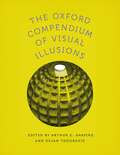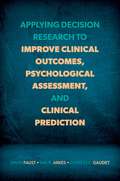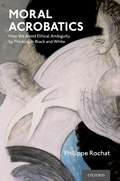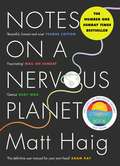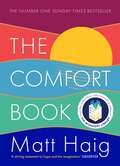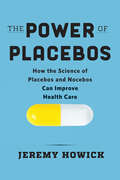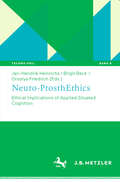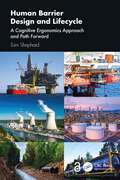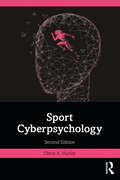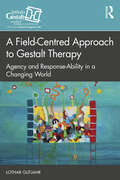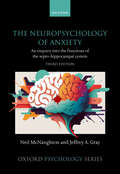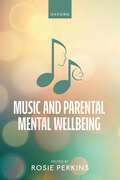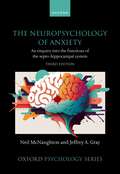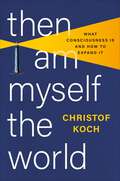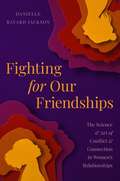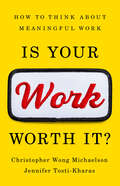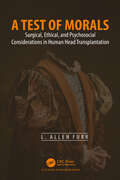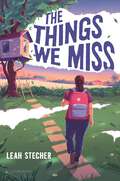- Table View
- List View
The Oxford Compendium of Visual Illusions
by Arthur Shapiro and Dejan TodorovićVisual illusions cut across academic divides and popular interests: on the one hand, illusions provide entertainment as curious tricks of the eye; on the other hand, scientific research related to illusory phenomena has given generations of scientists and artists deep insights into the brain and principles of mind and consciousness. Numerous thinkers (including Aristotle, Descartes, Da Vinci, Escher, Goethe, Galileo, Helmholtz, Maxwell, Newton, and Wittgenstein) have been lured by the apparent simplicity of illusions and the promise that illusory phenomena can elucidate the puzzling relationship between the physical world and our perceptual reality. Over the past thirty years, advances in imaging and electrophysiology has dramatically expanded the range of illusions and enabled new forms of analysis, thereby creating new and exciting ways to consider how the brain constructs our perceptual world. The Oxford Compendium of Visual Illusions is a collection of over one hundred chapters about illusions, displayed and discussed by the researchers who invented and conducted research on the illusions. Chapters include full-color images, associated videos, and extensive references. The book is divided into eleven sections: first, a presentation of general history and viewpoints on illusions, followed by sections on geometric, color, motion, space, faces, and cross-category illusions. The book will be of interest to vision scientists, neuroscientists, psychologists, physicists, philosophers, artists, designers, advertisers, and educators curious about applied aspects of visual perception and the brain.
Applying Decision Research to Improve Clinical Outcomes, Psychological Assessment, and Clinical Prediction
by David Faust Hal R. Arkes Charles E. GaudetMental health professionals often make explicit or implicit predictions involving crucial matters--Is a client at risk for self-harm or harming others? What treatment approach is most likely to be successful? Has a child been subjected to sexual or physical abuse? Decision research has particularly strong applied use for improving the accuracy of such determinations; unfortunately this work has not been broadly disseminated in the mental health field. Applying Decision Research to Improve Clinical Outcomes, Psychological Assessment, and Clinical Prediction introduces graduate students and practitioners in the mental health field to research, knowledge, and practical strategies that can enhance diagnostic and predictive accuracy and thereby improve client care. Major chapters of the book address well-established, but often under-recognized, principles and procedures for improving the integration of clinical data and interpretive accuracy; the differentiation between seemingly accurate but illusory, as opposed to genuine, associations between signs, symptoms, and outcomes; and the minimization of impediments to accurate decision making. The authors merge applied clinical tasks in the mental health field with decision research and cognitive psychology to suggest ways in which prediction, diagnosis, and assessment can be accomplished with greater efficacy and precision.
Moral Acrobatics: How We Avoid Ethical Ambiguity by Thinking in Black and White
by Philippe RochatAlthough it is difficult for us to fathom, pure monsters do not exist. Terrorists and other serial killers massacre innocent people, yet are perfectly capable of loving their own parents, neighbors, and children. Hitler, sending millions to their death, was contemptuous of meat eaters and a strong advocate of animal welfare. How do we reconcile such moral ambiguities? Do they capture something deep about how we build values? As a developmental scientist, Philippe Rochat explores this possibility, proposing that as members of a uniquely symbolic and self-conscious species aware of its own mortality, we develop uncanny abilities toward lying and self-deception. We are deeply categorical and compartmentalized in our views of the world. We imagine essence where there is none. We juggle double standards and manage contradictory values, clustering our existence depending on context and situations, whether we deal in relation to close kin, colleagues, strangers, lovers, or enemies. We live within multiple, interchangeable moral spheres. This social-contextual determination of the moral domain is the source of moral ambiguities and blatant contradictions we all need to own up to.
Applying Decision Research to Improve Clinical Outcomes, Psychological Assessment, and Clinical Prediction
by David Faust Hal R. Arkes Charles E. GaudetMental health professionals often make explicit or implicit predictions involving crucial matters--Is a client at risk for self-harm or harming others? What treatment approach is most likely to be successful? Has a child been subjected to sexual or physical abuse? Decision research has particularly strong applied use for improving the accuracy of such determinations; unfortunately this work has not been broadly disseminated in the mental health field. Applying Decision Research to Improve Clinical Outcomes, Psychological Assessment, and Clinical Prediction introduces graduate students and practitioners in the mental health field to research, knowledge, and practical strategies that can enhance diagnostic and predictive accuracy and thereby improve client care. Major chapters of the book address well-established, but often under-recognized, principles and procedures for improving the integration of clinical data and interpretive accuracy; the differentiation between seemingly accurate but illusory, as opposed to genuine, associations between signs, symptoms, and outcomes; and the minimization of impediments to accurate decision making. The authors merge applied clinical tasks in the mental health field with decision research and cognitive psychology to suggest ways in which prediction, diagnosis, and assessment can be accomplished with greater efficacy and precision.
Notes on a Nervous Planet
by Matt Haig*MATT HAIG’S NEW NOVEL THE LIFE IMPOSSIBLE IS AVAILABLE TO PRE-ORDER NOW * Order THE COMFORT BOOK. Available now! THE NUMBER ONE SUNDAY TIMES BESTSELLER The world is messing with our minds. Rates of stress and anxiety are rising. A fast, nervous planet is creating fast and nervous lives. We are more connected, yet feel more alone. And we are encouraged to worry about everything from world politics to our body mass index. – How can we stay sane on a planet that makes us mad? – How do we stay human in a technological world? – How do we feel happy when we are encouraged to be anxious? After experiencing years of anxiety and panic attacks, these questions became urgent matters of life and death for Matt Haig. And he began to look for the link between what he felt and the world around him. Notes on a Nervous Planet is a personal and vital look at how to feel happy, human and whole in the twenty-first century.
The Comfort Book: The instant No. 1 Sunday Times bestseller
by Matt Haig*MATT HAIG’S NEW NOVEL THE LIFE IMPOSSIBLE IS AVAILABLE TO PRE-ORDER NOW * THE INSTANT NUMBER ONE SUNDAY TIMES BESTSELLER 'Profound, witty and uplifting' Observer 'Full of eloquent, cogent and positive reminders of the beauty of life' Independent The Comfort Book is a collection of consolations learned in hard times and suggestions for making the bad days better. Drawing on maxims, memoir and the inspirational lives of others, these meditations offer new ways of seeing ourselves and the world. This is the book to pick up when you need the wisdom of a friend, the comfort of a hug or a reminder that hope comes from unexpected places.
The Power of Placebos: How The Science Of Placebos And Nocebos Can Improve Health Care
by Jeremy HowickThe Power Of Placebos: How The Science Of Placebos And Nocebos Can Improve Health Care
by Jeremy HowickNeuro-ProsthEthics: Ethical Implications of Applied Situated Cognition (Techno:Phil – Aktuelle Herausforderungen der Technikphilosophie #9)
by Jan-Hendrik Heinrichs Birgit Beck Orsolya FriedrichThe volume focusses on the ethical dimensions of the technological scaffold embedding human thought and action, which has been brought to attention of the cognitive sciences by situated cognition theories. There is a broad spectrum of technologies co-realising or enabling and enhancing human cognition and action, which vary in the degree of bodily integration, interactivity, adaptation processes, of reliance and indispensability etc. This technological scaffold of human cognition and action evolves rapidly. Some changes are continuous, some are eruptive. Technologies that use machine learning e.g. could represent a qualitative leap in the technological scaffolding of human cognition and actions. The ethical consequences of applying situated cognition theories to practical cases had yet to find adequate attention and are elucidated in this volume.
Human Barrier Design and Lifecycle: A Cognitive Ergonomics Approach and Path Forward
by Tom ShephardA common source of failure in a human‑dependent barrier or safety critical task is a designed‑in mismatch error. The mismatch is a cognitive demand that exceeds the human capability to reliably and promptly respond to that demand given the plausible situations at that moment. Demand situations often include incomplete information, increased time pressures, and challenging environments. This book presents innovative solutions to reveal, prevent, and mitigate these and many other cognitive‑type errors in barriers and safety critical tasks. The comprehensive model and methodologies also provide insight into where and to what extent these barriers and task types may be significantly underspecified and the potential consequences.This title presents a new and comprehensive prototype design and lifecycle model specific to human‑dependent barriers and safety critical tasks. Designed to supplement current practice, the model is fully underpinned by cognitive ergonomics and cognitive science. The book also presents a compelling case for why a new global consensus standard specific to human‑dependent barriers is needed. Taking a novel approach, it presents its suggested basis, framing, and content. Both solutions seek to redress deficiencies in global regulations, standards, and practice. The model is guided by industry recommendations and best practice guidance and solutions from globally recognized experts. Its processes are fully explained and supported by examples, analysis, and well‑researched background materials. Real‑life case studies from offshore oil and gas, chemical manufacturing, transmission pipelines, and product storage provide further insight into how overt and latent design errors contributed to barrier degradation and failure and the consequence of those errors.An essential and fascinating read for professionals, Human Barrier Design and Lifecycle: A Cognitive Ergonomics Approach and Path Forward will appeal to those in the fields of human factors, process and technical safety, functional safety, display and safety system design, risk management, facility engineering, and facility operations and maintenance.Chapters 1 and 8 of this book are freely available as downloadable Open Access PDFs at http://www.crcpress.com under a Creative Commons Attribution-Non Commercial-No Derivatives (CC-BYNC-ND) 4.0 International license.
Human Barrier Design and Lifecycle: A Cognitive Ergonomics Approach and Path Forward
by Tom ShephardA common source of failure in a human‑dependent barrier or safety critical task is a designed‑in mismatch error. The mismatch is a cognitive demand that exceeds the human capability to reliably and promptly respond to that demand given the plausible situations at that moment. Demand situations often include incomplete information, increased time pressures, and challenging environments. This book presents innovative solutions to reveal, prevent, and mitigate these and many other cognitive‑type errors in barriers and safety critical tasks. The comprehensive model and methodologies also provide insight into where and to what extent these barriers and task types may be significantly underspecified and the potential consequences.This title presents a new and comprehensive prototype design and lifecycle model specific to human‑dependent barriers and safety critical tasks. Designed to supplement current practice, the model is fully underpinned by cognitive ergonomics and cognitive science. The book also presents a compelling case for why a new global consensus standard specific to human‑dependent barriers is needed. Taking a novel approach, it presents its suggested basis, framing, and content. Both solutions seek to redress deficiencies in global regulations, standards, and practice. The model is guided by industry recommendations and best practice guidance and solutions from globally recognized experts. Its processes are fully explained and supported by examples, analysis, and well‑researched background materials. Real‑life case studies from offshore oil and gas, chemical manufacturing, transmission pipelines, and product storage provide further insight into how overt and latent design errors contributed to barrier degradation and failure and the consequence of those errors.An essential and fascinating read for professionals, Human Barrier Design and Lifecycle: A Cognitive Ergonomics Approach and Path Forward will appeal to those in the fields of human factors, process and technical safety, functional safety, display and safety system design, risk management, facility engineering, and facility operations and maintenance.Chapters 1 and 8 of this book are freely available as downloadable Open Access PDFs at http://www.crcpress.com under a Creative Commons Attribution-Non Commercial-No Derivatives (CC-BYNC-ND) 4.0 International license.
Sport Cyberpsychology
by Olivia A. HurleyThe new edition of Sport Cyberpsychology is the only textbook in this field that provides a detailed overview of theories, concepts and research findings specifically related to the discipline of sport cyberpsychology. Post-pandemic, this new edition explores the vast psychological impact technology has on athletes' thoughts, emotions and preparations for their sport, as well as the role technology plays in sport consulting, officiating and social interactions. It covers topics that include performance-enhancing technologies, social media use by athletes and sport personnel (e.g., sport officials) and the role of technology in sport psychology consulting. Problematic behaviours athletes may encounter or engage in within the online world, such as their experiences with cyberbullying and online gambling are also discussed.This second edition includes a review of the latest esports research and activities that are gaining global popularity. The final chapter presents some new research horizons in the field of sport cyberpsychology. The book includes a range of helpful features including case studies, open-ended discussion questions, suggestions for future research studies and extensive reference lists.Accessibly written, this edition of Sport Cyberpsychology offers a one-stop, engaging resource for students and instructors alike. It is important reading for students of sport psychology, cyberpsychology, sport coaching, sport officiating and sport technology, as well as coaches, traditional athletes, esports athletes, sport scientists and performers in areas such as dance, the arts, the military and medicine.
Sport Cyberpsychology
by Olivia A. HurleyThe new edition of Sport Cyberpsychology is the only textbook in this field that provides a detailed overview of theories, concepts and research findings specifically related to the discipline of sport cyberpsychology. Post-pandemic, this new edition explores the vast psychological impact technology has on athletes' thoughts, emotions and preparations for their sport, as well as the role technology plays in sport consulting, officiating and social interactions. It covers topics that include performance-enhancing technologies, social media use by athletes and sport personnel (e.g., sport officials) and the role of technology in sport psychology consulting. Problematic behaviours athletes may encounter or engage in within the online world, such as their experiences with cyberbullying and online gambling are also discussed.This second edition includes a review of the latest esports research and activities that are gaining global popularity. The final chapter presents some new research horizons in the field of sport cyberpsychology. The book includes a range of helpful features including case studies, open-ended discussion questions, suggestions for future research studies and extensive reference lists.Accessibly written, this edition of Sport Cyberpsychology offers a one-stop, engaging resource for students and instructors alike. It is important reading for students of sport psychology, cyberpsychology, sport coaching, sport officiating and sport technology, as well as coaches, traditional athletes, esports athletes, sport scientists and performers in areas such as dance, the arts, the military and medicine.
A Field-Centred Approach to Gestalt Therapy: Agency and Response-ability in a Changing World (The Gestalt Therapy Book Series)
by Lothar GutjahrIn Gestalt therapy, sociological, political, and economic research is often neglected or ignored. Drawing on analyses about current societal conditions, this book considers that there is no such thing as a ‘postmodern’ therapy and offers a new approach to Gestalt therapy.Gestalt therapy is still currently based on the Cartesian worldview, even if relational approaches are in search for an ‘in-between’. The author’s approach of Gestalt therapy is based on an idea by the founders: “Contact is the first reality” – so the field coemerges and coexists with individuals’ perceptions providing specific conditions, demands, limitations and opportunities. An individual’s field is not an afterthought established by the perspective of the first-person-singular (i.e. individuals) but a ‘conditio sine qua non’. Gutjahr reflects on both theoretical and practical aspects of the field’s many processes of resonance. Putting the field consistently at the centre of his approach, the author describes the main tenets expanding on previous versions of Gestalt therapy.This important new book is at the cutting edge of the current discussion of relational and field-oriented approaches to Gestalt therapy, and will be of particular interest to practitioners of Gestalt therapy, psychotherapists, phenomenologists, as well as theorists of philosophy, sociology and therapy.
The Neuropsychology of Anxiety: An enquiry into the functions of the septo-hippocampal system (Oxford Psychology Series)
by Prof Neil McNaughton Prof Jeffrey A. GrayThe Neuropsychology of Anxiety first appeared in 1982 as the first volume in the Oxford Psychology Series, and it quickly established itself as a classic work in the psychology and neuroscience literature. It presented an innovative, and at times controversial, theory of anxiety and the brain systems, especially the septo-hippocampal system, that subserve it. This completely updated and revised third edition provides a further updated theory of septo hippocampal function combined with an improved understanding of anxiety. The book includes a new chapter on prefrontal cortex integrating frontal and hippocampal views of anxiety, as well as an extensively modified chapter on personality providing a new basis for further developments of Reinforcement Sensitivity Theory. In addition, numerous figures have been fully updated and converted to colour to support the text. This book is essential for postgraduate students and researchers in experimental psychology and neuroscience, as well as for all clinical psychologists and psychiatrists.
A Field-Centred Approach to Gestalt Therapy: Agency and Response-ability in a Changing World (The Gestalt Therapy Book Series)
by Lothar GutjahrIn Gestalt therapy, sociological, political, and economic research is often neglected or ignored. Drawing on analyses about current societal conditions, this book considers that there is no such thing as a ‘postmodern’ therapy and offers a new approach to Gestalt therapy.Gestalt therapy is still currently based on the Cartesian worldview, even if relational approaches are in search for an ‘in-between’. The author’s approach of Gestalt therapy is based on an idea by the founders: “Contact is the first reality” – so the field coemerges and coexists with individuals’ perceptions providing specific conditions, demands, limitations and opportunities. An individual’s field is not an afterthought established by the perspective of the first-person-singular (i.e. individuals) but a ‘conditio sine qua non’. Gutjahr reflects on both theoretical and practical aspects of the field’s many processes of resonance. Putting the field consistently at the centre of his approach, the author describes the main tenets expanding on previous versions of Gestalt therapy.This important new book is at the cutting edge of the current discussion of relational and field-oriented approaches to Gestalt therapy, and will be of particular interest to practitioners of Gestalt therapy, psychotherapists, phenomenologists, as well as theorists of philosophy, sociology and therapy.
Music and Parental Mental Wellbeing
by Rosie PerkinsThere is compelling evidence that music can enhance parental wellbeing, yet to date there have been few attempts to bring together current endeavours in the field. Music and Parental Mental Wellbeing provides readers from music, health, and beyond, with a new and comprehensive opportunity to consider how music can support parental mental wellbeing. Drawing on recent ground-breaking practice, research, and evaluation the book illuminates how music can support mental wellbeing in pregnancy and the postnatal period, childbirth and perinatal hospital settings, and in the early years. Each chapter provides introductory context, describes the relevant musical practice, consider the intersections with parental wellbeing, and end with implications for practice and key take-aways for the reader. With an interdisciplinary and international team of authors, including music and health practitioners, experts by experience, and researchers, this book explores and establishes the role of music, in its many forms, in supporting and enhancing parental mental wellbeing.
Music and Parental Mental Wellbeing
by Rosie PerkinsThere is compelling evidence that music can enhance parental wellbeing, yet to date there have been few attempts to bring together current endeavours in the field. Music and Parental Mental Wellbeing provides readers from music, health, and beyond, with a new and comprehensive opportunity to consider how music can support parental mental wellbeing. Drawing on recent ground-breaking practice, research, and evaluation the book illuminates how music can support mental wellbeing in pregnancy and the postnatal period, childbirth and perinatal hospital settings, and in the early years. Each chapter provides introductory context, describes the relevant musical practice, consider the intersections with parental wellbeing, and end with implications for practice and key take-aways for the reader. With an interdisciplinary and international team of authors, including music and health practitioners, experts by experience, and researchers, this book explores and establishes the role of music, in its many forms, in supporting and enhancing parental mental wellbeing.
The Neuropsychology of Anxiety: An enquiry into the functions of the septo-hippocampal system (Oxford Psychology Series)
by Prof Neil McNaughton Prof Jeffrey A. GrayThe Neuropsychology of Anxiety first appeared in 1982 as the first volume in the Oxford Psychology Series, and it quickly established itself as a classic work in the psychology and neuroscience literature. It presented an innovative, and at times controversial, theory of anxiety and the brain systems, especially the septo-hippocampal system, that subserve it. This completely updated and revised third edition provides a further updated theory of septo hippocampal function combined with an improved understanding of anxiety. The book includes a new chapter on prefrontal cortex integrating frontal and hippocampal views of anxiety, as well as an extensively modified chapter on personality providing a new basis for further developments of Reinforcement Sensitivity Theory. In addition, numerous figures have been fully updated and converted to colour to support the text. This book is essential for postgraduate students and researchers in experimental psychology and neuroscience, as well as for all clinical psychologists and psychiatrists.
Then I Am Myself the World: What Consciousness Is and How to Expand It
by Christof Koch"Deeply personal and infinitely digestible, Then I Am Myself the World is a remarkable must-read for anyone interested in knowing their mind.&”―Judson Brewer MD, PhD, New York Times–bestselling author of Unwinding Anxiety The world&’s leading investigator of consciousness argues that by understanding what consciousness does—cause change in the world—we can understand its origins and its future In Then I Am Myself the World, Christof Koch explores the only thing we directly experience: consciousness. At the book&’s heart is integrated-information theory, the idea that the essence of consciousness is the ability to exert causal power over itself, to be an agent of change. Koch investigates the physical origins of consciousness in the brain and how this knowledge can be used to measure consciousness in natural and artificial systems. Enabled by such tools, Koch reveals when and where consciousness exists, and uses that knowledge to confront major social and scientific questions: When does a fetus first become self-aware? Can psychedelic and mystical experiences transform lives? What happens to consciousness in near-death experiences? Why will generative AI ultimately be able to do the very thing we can do, yet never feel any of it? And do our experiences reveal a single, objective reality? This is an essential book for anyone who seeks to understand ourselves and the future we are creating.
Fighting for Our Friendships: The Science and Art of Conflict and Connection in Women's Relationships
by Danielle Bayard JacksonWhy are women's friendships so deep yet so fragile? Friendship coach and educator Danielle Bayard Jackson unpacks the latest research about women's cooperation and communication, while sharing practical strategies to preserve and strengthen these relationships.Fighting for Our Friendships is one part textbook, one part handbook. Readers will not only learn what the latest research has to say about the mechanics of women's friendships, but they'll walk away with real-life solutions for the most common conflicts that arise in their platonic relationships. Using a combination of psychology, science, narrative, and a few of the author's signature scripts and out-of-the-box exercises, readers will learn: The three "affinities" that bring women together (and tear them apart) Scripts to navigate nine of the most challenging "friend types" (and how to know which one you are) The covert strategies women use to hurt each other (and how to avoid them) How to have a hard conversation with a friend (without losing the friendship) Surprising ways that women's people-pleasing delays platonic intimacy (and how to stop it) How to know if a friendship is worth saving (and what to do to recover) How to make (and deepen!) connections with other women In a time when we are often encouraged to opt out of friendships at any sign of friction, Danielle Bayard Jackson is showing us how to opt in.
Is Your Work Worth It?: How to Think About Meaningful Work
by Christopher Wong Michaelson Jennifer Tosti-KharasWhat is work that&’s worth doing in a life worth living? A revealing exploration of the questions we ask and the stories we tell about our work. According to recent studies, barely a third of American workers feel &“engaged&” at work, and for many people around the world, happiness is lowest when earning power is highest. After a global pandemic that changed why, how, and what people do for a living, many workers find themselves wondering what makes their daily routine worthwhile. In Is Your Work Worth It?, two professors – a philosopher and organizational psychologist – investigate the purpose of work and its value in our lives. The book explores vital questions, such as: Should you work for love or money? When and how much should you work? What would make life worth living in a world without work? What kind of mark will your work leave on the world? This essential book combines inspiring and harrowing stories of real people with recent scholarship, ancient wisdom, arts, and literature to help us clarify what worthy work looks like, what tradeoffs are acceptable to pursue it, and what our work can contribute to society.
A Test of Morals: Surgical, Ethical, and Psychosocial Considerations in Human Head Transplantation
by L. Allen FurrWhile transplanting human heads is not a new concept, the idea has largely been relegated to religious lore or as a plot device in science fiction. But now, a surgical plan to perform the complex procedure exists, and though most physicians question head transplantation’s medical veracity, bioethicists have challenged the surgery on moral grounds. A Test of Morals compiles and examines the ethical questions that dog those who advocate for conducting this most radical of medical proposals in order to determine if society should move forward and allow head transplantation to occur. Current bioethical principles stand in opposition to head transplantation, causing a conflict of values rarely seen in medicine.
A Test of Morals: Surgical, Ethical, and Psychosocial Considerations in Human Head Transplantation
by L. Allen FurrWhile transplanting human heads is not a new concept, the idea has largely been relegated to religious lore or as a plot device in science fiction. But now, a surgical plan to perform the complex procedure exists, and though most physicians question head transplantation’s medical veracity, bioethicists have challenged the surgery on moral grounds. A Test of Morals compiles and examines the ethical questions that dog those who advocate for conducting this most radical of medical proposals in order to determine if society should move forward and allow head transplantation to occur. Current bioethical principles stand in opposition to head transplantation, causing a conflict of values rarely seen in medicine.
The Things We Miss
by Leah Stecher"Magical and heartbreaking! You will read this book in one gulp." - Jennifer L. Holm, New York Times-bestselling author of The Fourteenth GoldfishWhen You Reach Me meets Starfish in this heartfelt contemporary middle grade about a misfit girl who finds a way to skip all of the hard parts of life.J.P. Green has always felt out of step. She doesn't wear the right clothes, she doesn't say the right things, and her body…well, she'd rather not talk about it. And seventh grade is shaping up to be the worst year yet. So when J.P. discovers a mysterious door in her neighbor's treehouse, she doesn't hesitate before walking through. The door sends her three days forward in time. Suddenly, J.P. can skip all the worst parts of seventh grade: Fitness tests in P.E., oral book reports, awkward conversations with her mom…she can avoid them all and no one even knows she was gone.But can you live a life without any of the bad parts? Are there experiences out there that you can't miss?This moving middle grade novel about mental health, body acceptance, and self-confidence asks what it truly means to show up for the people you love-and for yourself.
